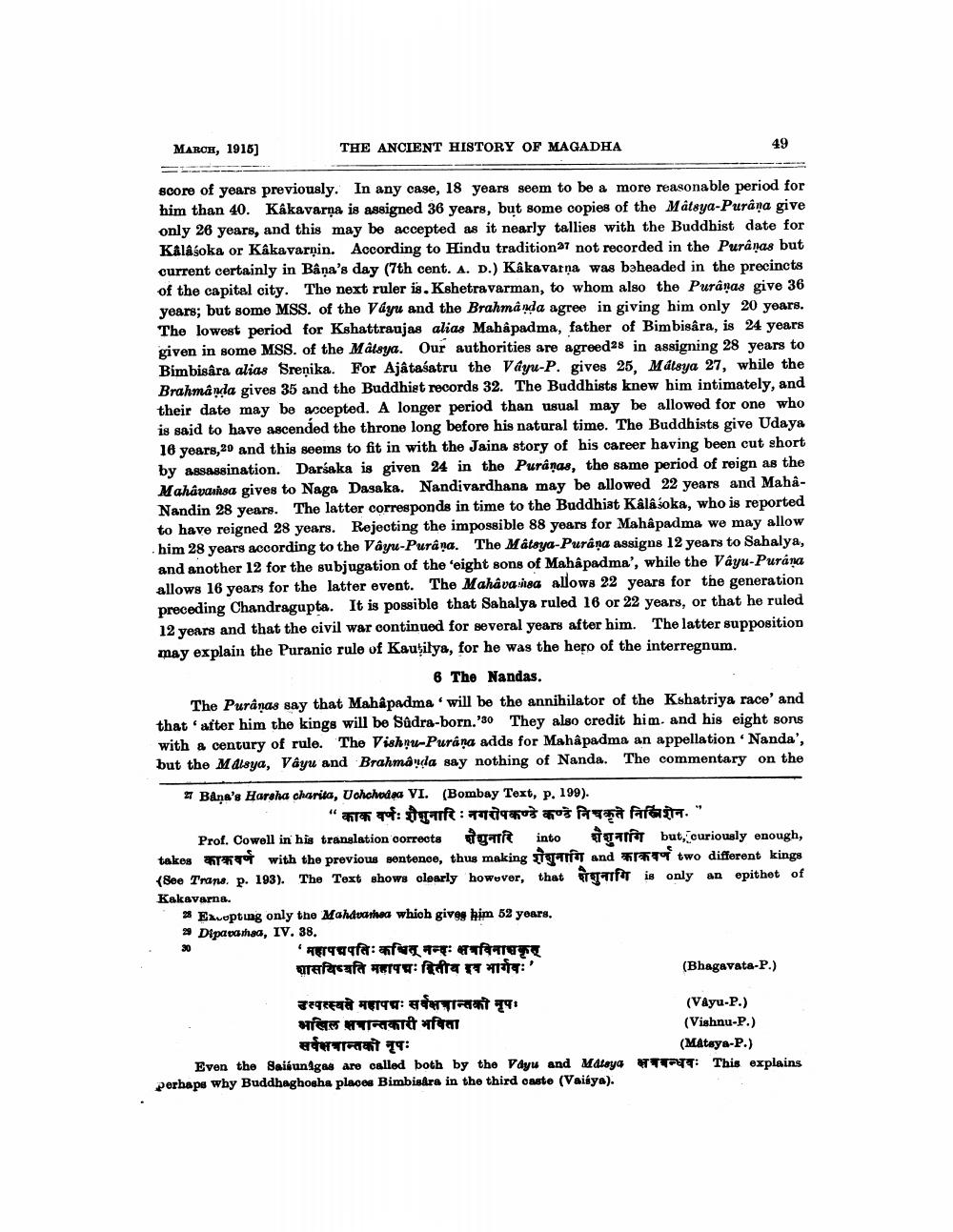________________
MARCH, 1916)
THE ANCIENT HISTORY OF MAGADHA
49
score of years previously. In any case, 18 years seem to be a more reasonable period for him than 40. Kakavarṇa is assigned 36 years, but some copies of the Matsya-Purâna give only 26 years, and this may be accepted as it nearly tallies with the Buddhist date for Kalasoka or Kakavarnin. According to Hindu tradition7 not recorded in the Puranas but current certainly in Bâna's day (7th cent. A. D.) Kâkavarna was baheaded in the precincts of the capital city. The next ruler is. Kshetravarman, to whom also the Purâņas give 36 years; but some MSS. of the Vayu and the Brahmânda agree in giving him only 20 years. The lowest period for Kshattraujas alias Mahậpadma, father of Bimbisára, is 24 years given in some MSS. of the Matsya. Our authorities are agreed2s in assigning 28 years to Bimbisâra alias Srenika. For Ajâtaśatru the Vayu-P. gives 25. Matsya 27, while the Brahmânda gives 35 and the Buddhist records 32. The Buddhists knew him intimately, and their date may be accepted. A longer period than usual may be allowed for one who is said to have ascended the throne long before his natural time. The Buddhists give Udaya 16 years, 20 and this seems to fit in with the Jaina story of his career having been cut short by assassination. Darsaka is given 24 in the Puranas, the same period of reign as the Mahavainsa gives to Naga Dasaka. Nandivardhana may be allowed 22 years and MahaNandin 28 years. The latter corresponds in time to the Buddhist Kalásoka, who is reported to have reigned 28 years. Rejecting the impossible 88 years for Mahậpadma we may allow him 28 years according to the Vayu-Purâna. The Matsya-Purâna assigns 12 years to Sabalya, and another 12 for the subjugation of the eight sons of Mahapadma', while the Vâyu-Purana allows 16 years for the latter event. The Mahavarisa allows 22 years for the generation preceding Chandragupta. It is possible that Sahalya ruled 16 or 22 years, or that he ruled 12 years and that the civil war continued for several years after him. The latter supposition may explain the Puranic rule of Kautilya, for he was the hero of the interregnum.
6 The Nandas. The Puranas say that Mahậpadmawill be the annihilator of the Kshatriya race' and that after him the kings will be Sadra-born.'80 They also credit him and his eight sons with a century of rule. The Vishnu-Purana adds for Mahapadma an appellation Nanda', but the Malaya, Vayu and Brahmayda say nothing of Nanda. The commentary on the
27 Bana's Harsha charita, Uchchadaa VI. (Bombay Text, p. 199).
" to: tarf: Tis o far na farasta." Prof. Cowell in his translation Corrects igarh into garft but, curiously enough, takes *** with the previous sentence, thus making tgart and to two different kings (See Trans, p. 193). The Text shows clearly however, that area is only an epithet of Kakavarna. 2 Eavopting only the Maharashea which give him 52 years, Diparamsa, IV. 38.
'महापचपतिःकश्चित् मन्दः सबविनाशकृत् शासविष्यति महापचः द्वितीय व भार्गवः'
(Bhagavata-P.)
उत्पत्स्वते महापत्रः सर्वक्षचान्सको नृपः भखिल मचान्तकारी भविता
सर्वक्षत्रान्तको नृपः Even the saibunigas are called both by the Vayu and Malaya W perhaps why Buddhaghosha places Bimbiadra in the third onto (Vainya).
(Vâyu-P.). (Vishnu-P.) (Mataya-P.) T This explains
P




